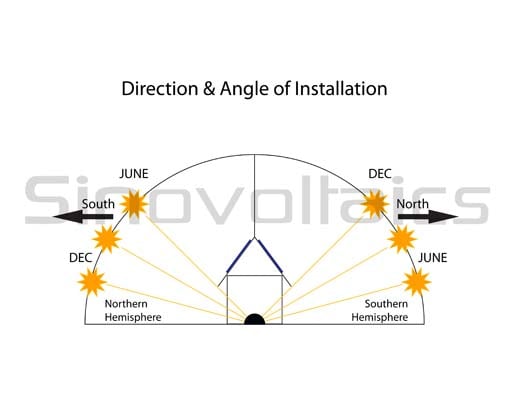For example if you are seeking to maximise solar generation during winter months be it for an off grid system or higher energy consumption levels you would ideally want to angle your panels at a greater tilt for maximum exposure to the low winter sun.
Solar panel angle of incidence efficiency.
If your solar panels will have a fixed tilt angle and you want to get the most energy over the whole year then this section is for you.
A flat roof has a 0 degree tilt and a vertical wall mount has a 90 degree tilt angle.
Elevation angle and azimuth angle commonly shortened to angle and azimuth for brevity.
This is the angle between the line that points to the sun and the angle that points straight out of a pv panel also called the line that is normal to the surface of the panel.
The violet line is the solar energy per day if the panel is fixed at the winter angle discussed below these figures are calculated for 40 latitude.
Optimum angle differs during winter months.
To get the best out of your photovoltaic panels you need to angle them towards the sun.
While the angle of your solar panels is important a more important factor in your energy production is going to be the direction your panels face.
This solar angle calculator tells you the optimum angle to get the best out of your system.
This is because the sun is always in the southern half of the sky in the northern hemisphere.
This is the most important angle.
Ir 1 tang 0 0.
The optimum angle varies throughout the year depending on the seasons and your location and this calculator shows the difference in sun height on a month by month.
Orientation of the panels.
The vertical tilt of your panels.
Welcome to another entry in our ongoing solar 101 series.
Today we re going to explain how to mount your solar panels to get the most energy from them.
The array s tilt is the angle in degrees from horizontal.
Whether you are installing a solar panel on a flat roof or a pitched roof the output of the solar pv system would be increased by optimizing the tilt angle.
Let s start with two key terms.
Solar panels are most efficient when pointing at the sun so engineers want to minimize this angle at all times.
For the best results solar panels should be oriented towards the south.
The angle of the sun varies throughout the year as illustrated in figure 9.
White background 10 soiled black background module technology measured angle of incidence dependence vs cosine model 0 30 60 90 angle of incidence 10 deg reflection loss dependence on angle of incidence r z to im do ule surface it from fresnel s law.
Orienting the pv panel in a direction and tilt to maximize its exposure to direct sunlight will optimize the collection efficiency.





































